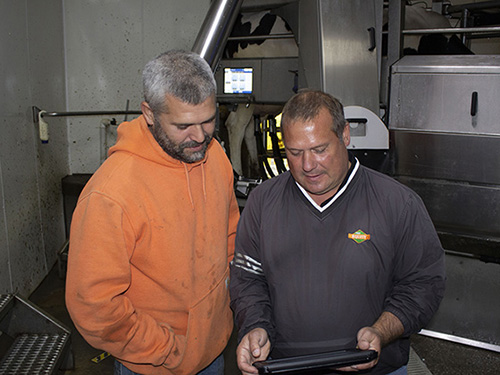Dairy Management
Though most dairies in our delivery area are ran by families that have been in the dairy industry many years, sometimes there are employees with not as much experience performing the more basic tasks. Our dairy consultants have put together the below to assist in the education of those individuals who are newer to the industry.
The first basic needs of the animal include fresh water, fresh feed, clean pens, space, and proper ventilation. When it comes to dairy calves, colostrum and the timing of colostrum are essential for health and growth. Cows produce antibody-rich colostrum prior to milk for their calves. Colostrum should be either drank from the mother or given via a bottle within the first four hours of birth. Without colostrum the calf will have a weakened immune system and struggle.
In addition to colostrum, the first round of vaccinations should be given at 8 to 12 weeks of age. For vaccinations, consult with your veterinarian.
After colostrum, dairy calves are taken to hutches for more individualized care. Their mother is still milked, but that milk is only given to calves and does not enter the bulk milk tank that is sold.
Each calf should be identified and monitored for weight gain and health. If health issues are noticed, a disinfect pen should be established that allows for doctoring, observing, and providing extra care to those animals. They should also be evaluated as to the possibility of either keeping that calf to be a replacement sire or dam on the farm because of their phenotype and genotype or being raised for harvest to provide nutritious meat.
Bulls and heifers that have been chosen to carry on the blood lines should be given second round vaccinations. This is also the time to dehorn, deworm, and do genomics tests. From genomic results, current blood lines, and traits you are wanting to promote in the herd, appropriate dam and sire matches are chosen. Once the animals are to the age and size of breeding at around 12 to 15 months, breeding is performed either through artificial insemination or naturally. Sometimes grouping together batches of heifers and cows and breeding within a close window is done to allow specialized care to be on hand for calving at the end of the 283-day gestation period.
Dietary cation-anion difference (DCAD) nutrition programs are utilized to shorten the dry period cows have after calving.
Lactating cows should stay on a consistent feed, milking, and reproductive cycle. Feed management and rations are especially critical when cows are lactating because the feed that goes in will help or hinder milk production, which must be balanced with the feed budget. The mobility of cows to get to the feed trough, milking parlor, and pens is vital, so much care goes into trimming hoofs regularly and footbaths.
During the summer months fly control should be used to decrease the ability to carry disease, as well as the annoyances of flies that cause the cows to be unsettled and decrease their rate of gain or milk production. Cooling is also important during the hot times of the year.

Dairy Team
The Equity Dairy Team has a wealth of knowledge and experience working with all ranges of dairies. Our Team not only consults on feed, we also provide added services to help our customers be more efficient, listed below.
- particle screening
- forage & ingredient sampling
- moisture testing
- Penn State Shaker Box
- manure screening
- ration balancing
- herd walkthroughs
- dairy records analysis
- risk management
- SCC Troubleshooting
- forage management
- facility consultation





